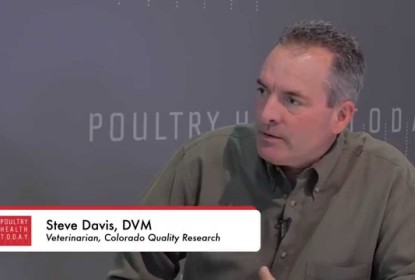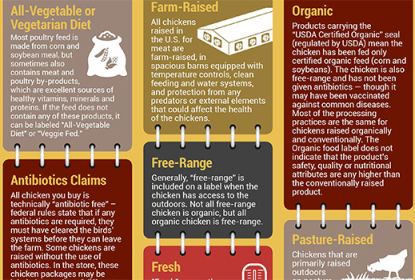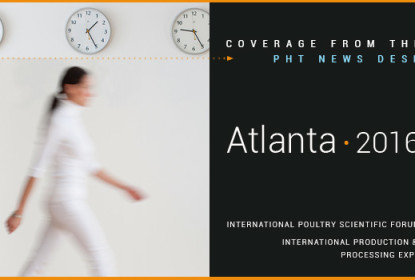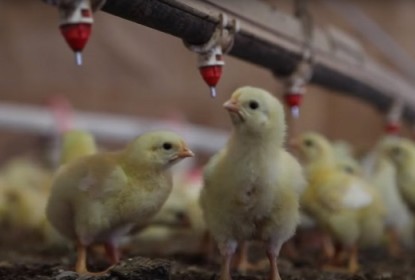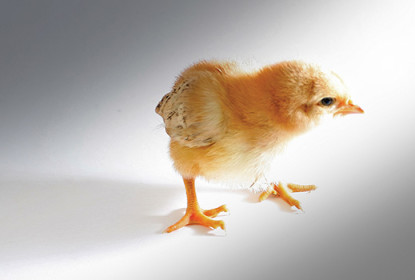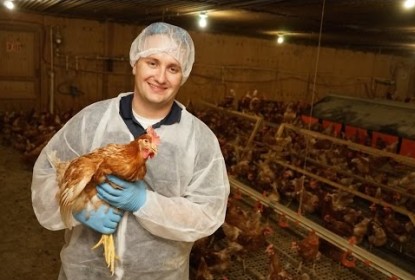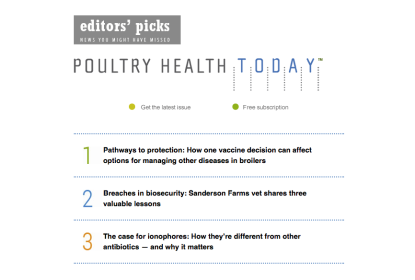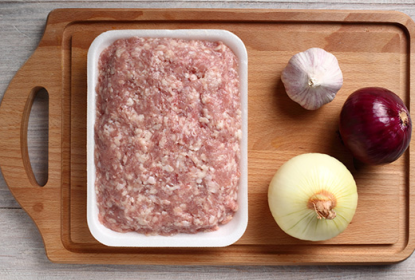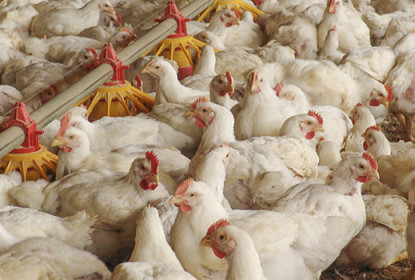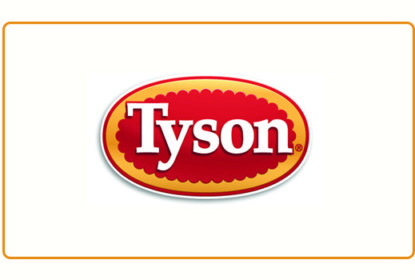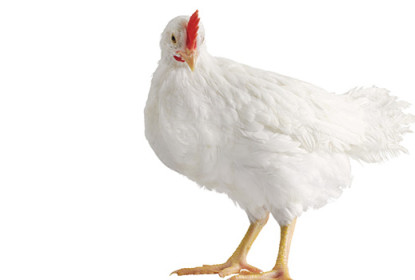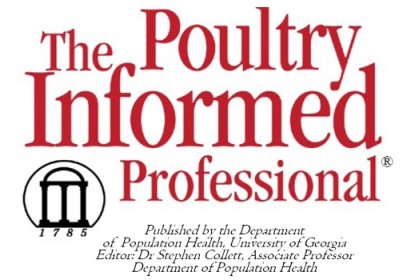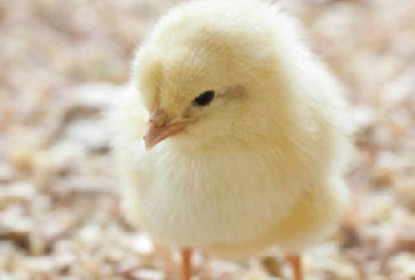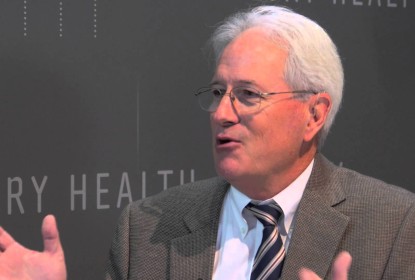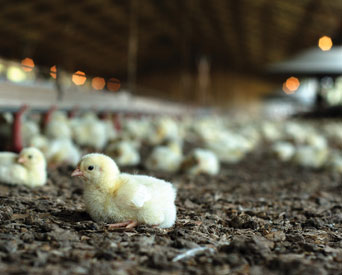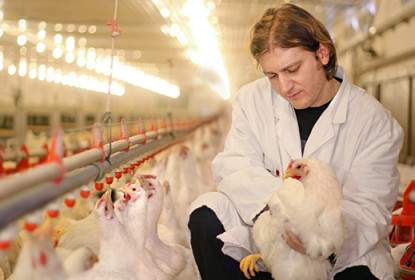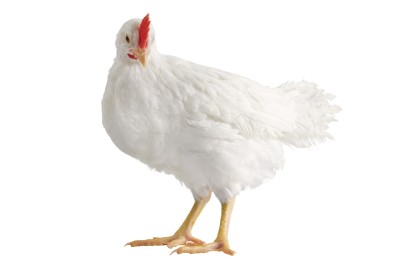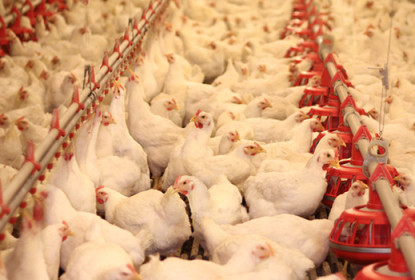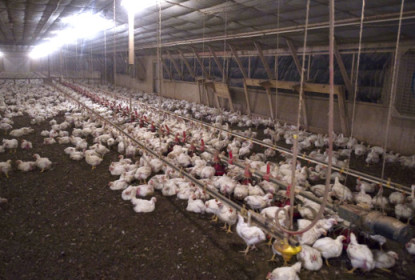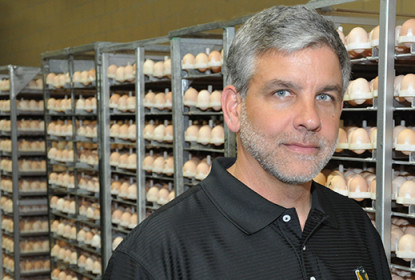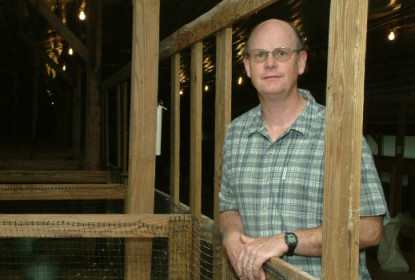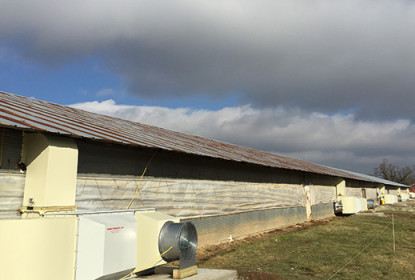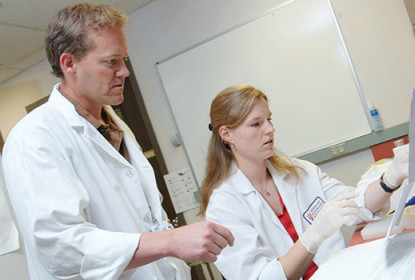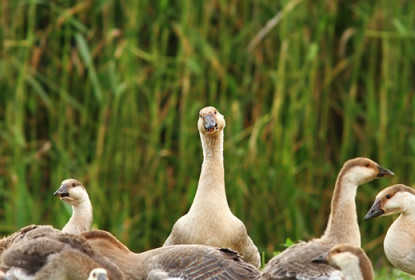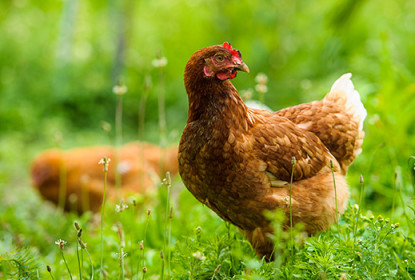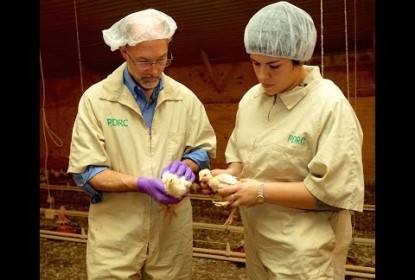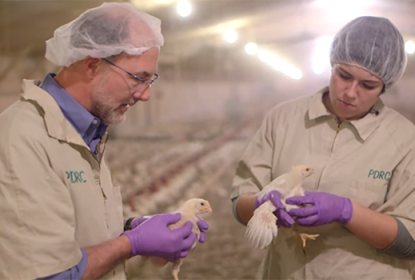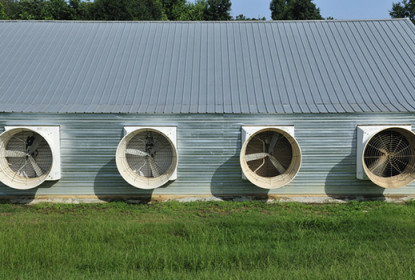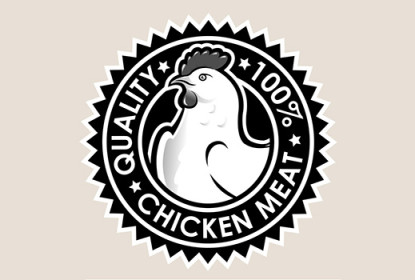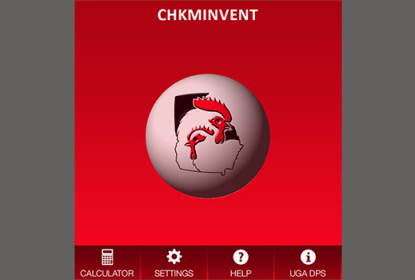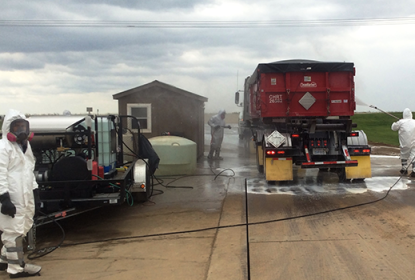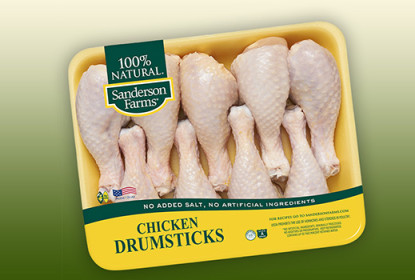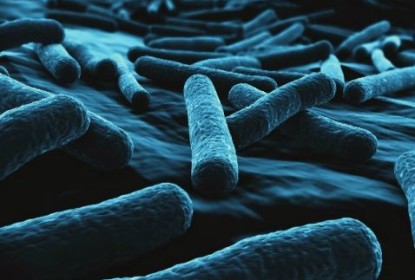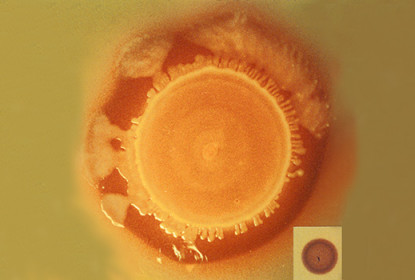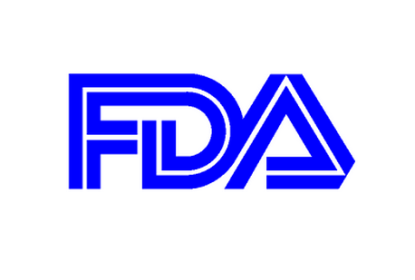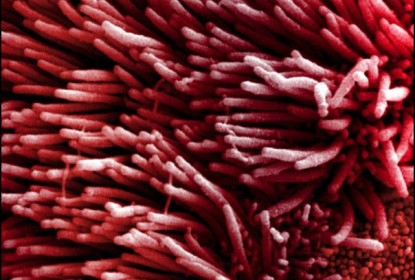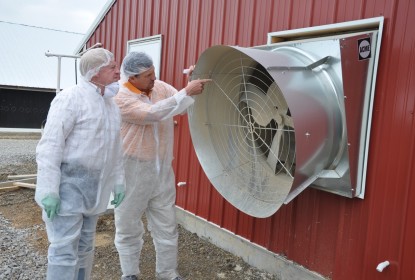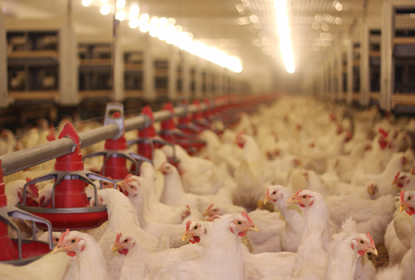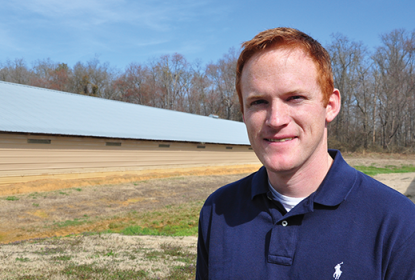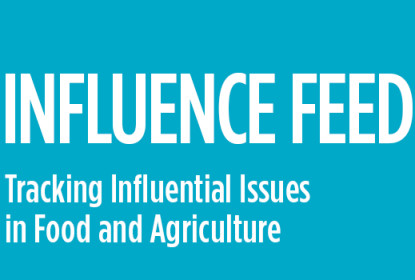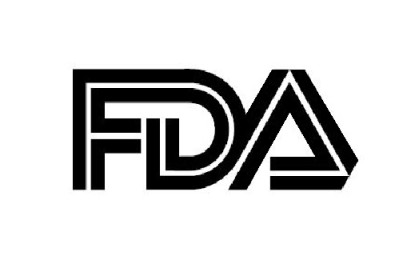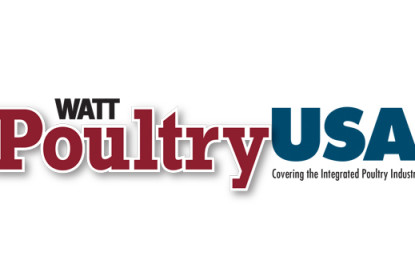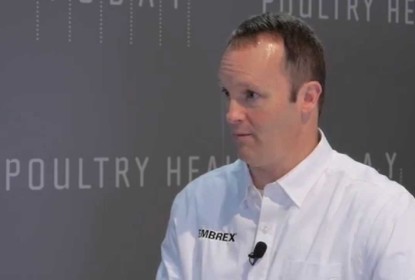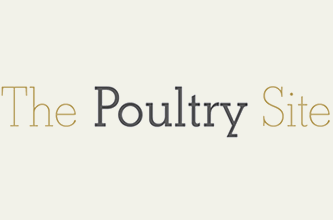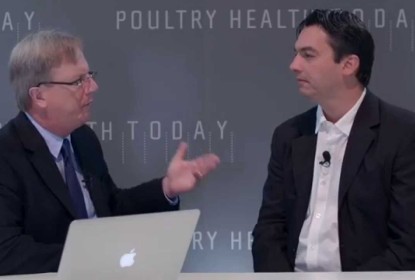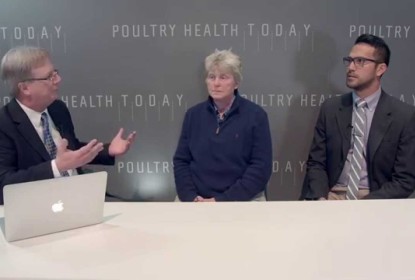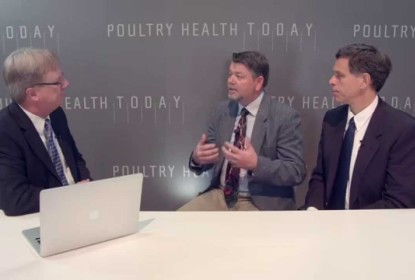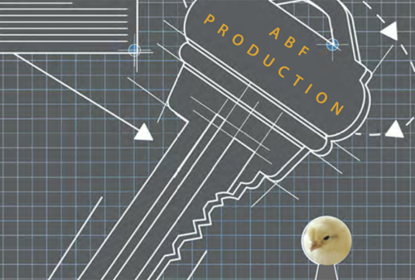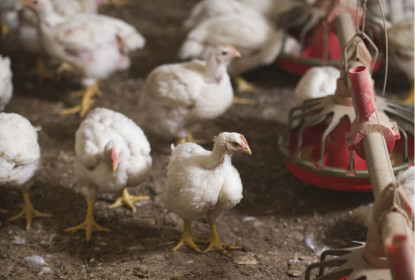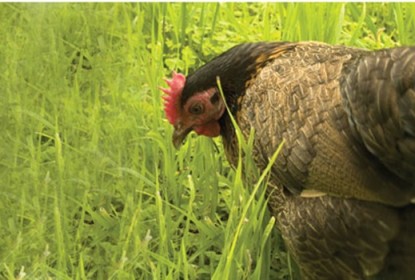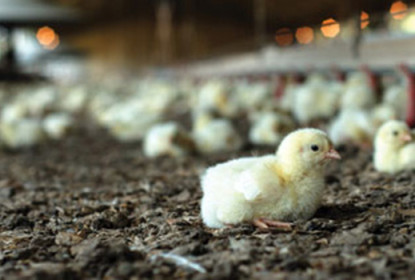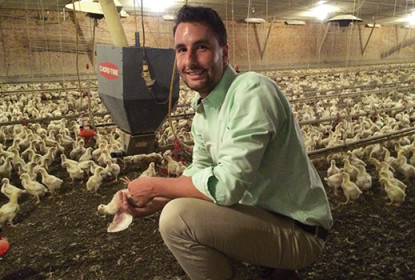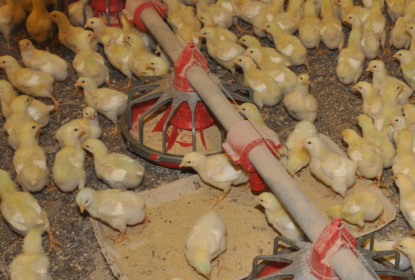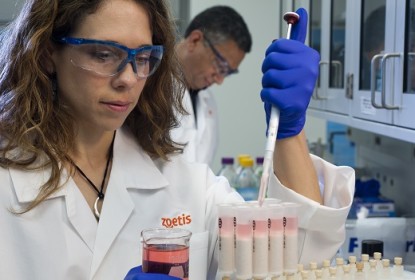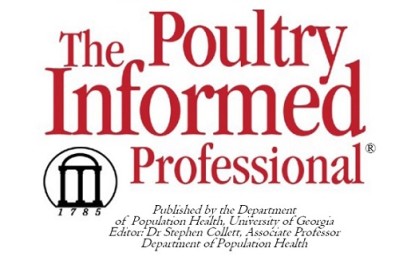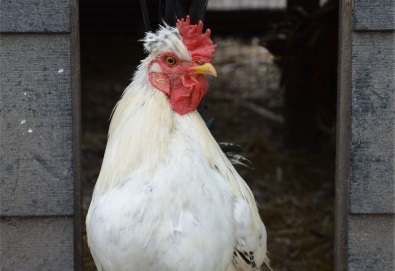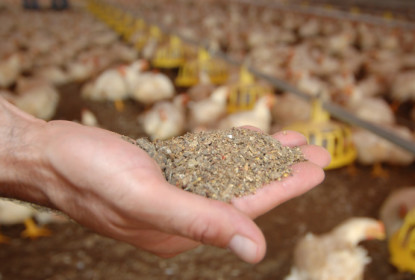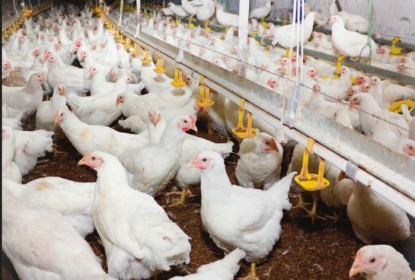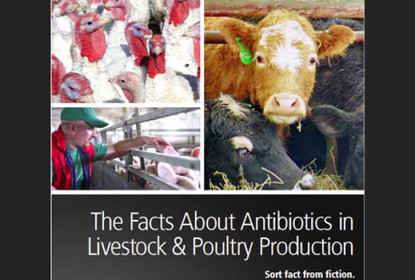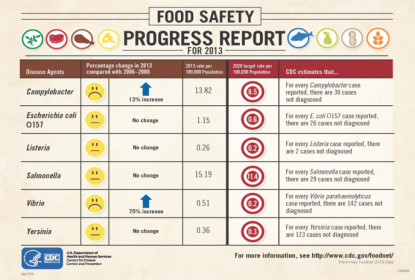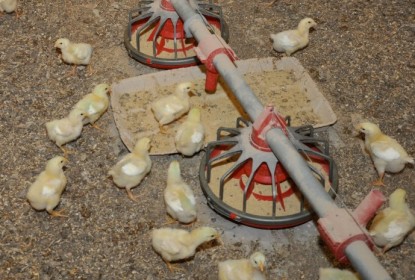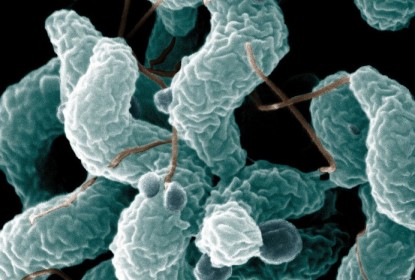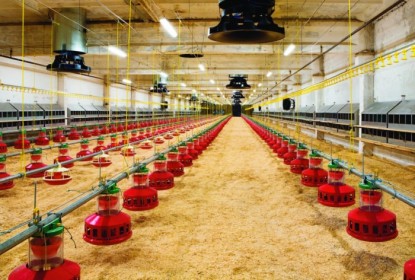Category Archive: Food Safety, Global TOP NEWS, ippe2016- Interviews with experts, News, PHT GLOBAL, PHT US, TOP NEWS, Videos

Food Safety, Global TOP NEWS, ippe2016- Interviews with experts, News, PHT GLOBAL, PHT US, TOP NEWS, Videos
... Meeting the new USDA/FSIS standards for Salmonella and Campylobacter in poultry
Apr 10, 2016Jennifer GrullonComments Off on Meeting the new USDA/FSIS standards for Salmonella and Campylobacter in poultry
USDA/FSIS issued new standards for Salmonella and Campylobacter in ground poultry meat and chicken and turkey parts.... Necrotic enteritis: In search of the silver bullet
Apr 09, 2016Jennifer GrullonComments Off on Necrotic enteritis: In search of the silver bullet
Steve Davis, DVM, of Colorado Quality Research says there’s no “silver bullet” for managing necrotic enteritis in broilers and shares his observations from recent studies.... NCC glossary brings clarity to chicken labeling
Apr 08, 2016Jennifer GrullonComments Off on NCC glossary brings clarity to chicken labeling
Consumer confusion about chicken labeling has prompted the National Chicken Council to develop an online glossary of terms often found on chicken meat labels.... Mountaire veterinarian discusses managing E. coli in broilers in the face of IBV infection
Apr 07, 2016Jennifer GrullonComments Off on Mountaire veterinarian discusses managing E. coli in broilers in the face of IBV infection
Don Ritter, DVM, of Mountaire Farms, details the company’s recent bout with IB in broilers and the costly secondary infection of E. coli that followed.... Sanderson veterinarian voices concerns about ‘anti-technology’ movement
Apr 07, 2016Jennifer GrullonComments Off on Sanderson veterinarian voices concerns about ‘anti-technology’ movement
The anti-technology trend that seems popular today has Phil Stayer, DVM, corporate veterinarian for Sanderson Farms, Inc., worried it could have far-reaching, unintended consequences for the industry...... Changes ahead: Everything you need to know about the new guidelines for oral antimicrobials
Apr 05, 2016Jennifer GrullonComments Off on Changes ahead: Everything you need to know about the new guidelines for oral antimicrobials
The US poultry industry has already shown that it knows how to use antimicrobials judiciously. In this special report, Poultry Health Today editors take an in-depth look at what FDA calls Guidance...... Randall Singer: Therapeutics and antibiotic resistance
Apr 03, 2016Jennifer GrullonComments Off on Randall Singer: Therapeutics and antibiotic resistance
By Randall S. Singer, DVM, MPVM, PhD Department of Veterinary and Biomedial Sciences University of Minnesota, St. Paul, MN
Announcements, Antibiotic-free, Flock welfare, Food Safety, Gut Health, Infectious Diseases, ippe2016 - Highlights from our latest issue, Mobile Only, News, PHT GLOBAL, PHT US
... Specialists explore new options for managing flock health while defending judicious antibiotic use
Mar 27, 2016Jennifer GrullonComments Off on Specialists explore new options for managing flock health while defending judicious antibiotic use
Growing demand for poultry raised without food-animal antibiotics has put more pressure on veterinarians to find alternative yet dependable disease-control options, according to a panel of nine...... Veterinary Feed Directive, Final Rule
Mar 24, 2016Jennifer GrullonComments Off on Veterinary Feed Directive, Final Rule
Amendment to FDA's animal drug regulations regarding VFD drugs, which is intended to improve the efficiency of the VFD program while protecting human and animal health.... Surprise bacterium linked to lameness in broilers
Mar 19, 2016Jennifer GrullonComments Off on Surprise bacterium linked to lameness in broilers
Staphylococcus agnetis, a bacterium not previously known to affect chickens is now thought to be the cause of lameness in broilers, according to University of Arkansas researchers.... Thinking about going antibiotic-free? Expert panel offers insights, suggestions
Mar 10, 2016Jennifer GrullonComments Off on Thinking about going antibiotic-free? Expert panel offers insights, suggestions
Broiler and turkey companies need to think carefully and weigh all the possible impacts before considering a move to antibiotic-free production, said poultry health experts at a panel discussion held...... Guidance for Industry No 120
Mar 08, 2016Jennifer GrullonComments Off on Guidance for Industry No 120
Small entity compliance guide, and questions and answers regarding veterinary feed directive regulations.... Guidance for Industry No 233
Mar 07, 2016Jennifer GrullonComments Off on Guidance for Industry No 233
Common questions and answers regarding veterinary feed directive regulations.... Guidance for Industry No 209
Mar 07, 2016Jennifer GrullonComments Off on Guidance for Industry No 209
Recommendations for the judicious use of medically important antimicrobial drugs in food-producing animals.... Guidance for Industry No 152
Mar 07, 2016Jennifer GrullonComments Off on Guidance for Industry No 152
Recommendations for assessing the safety of antimicrobial new animal drugs with regard to their microbiological effects on bacteria of human health concern.... Antibiotics in poultry requires ethical dialogue
Mar 04, 2016Jennifer GrullonComments Off on Antibiotics in poultry requires ethical dialogue
The editor of WATT PoultryUSA shares his thoughts on the US poultry industry. Gary Thornton discusses legislation, trends, food safety issues and more relating to the poultry and meat industries in...... Managing E. coli in broilers in the face of IBV infection
Feb 12, 2016Jennifer GrullonComments Off on Managing E. coli in broilers in the face of IBV infection
Don Ritter, DVM, of Mountaire Farms, Millsboro, Delaware, details the company’s recent bout with infectious bronchitis in broilers and the costly secondary infection of E. coli that followed.... UGA’s Mark Jackwood: Stop ‘shooting in the dark’ with bronchitis vaccination
Feb 11, 2016Jennifer GrullonComments Off on UGA’s Mark Jackwood: Stop ‘shooting in the dark’ with bronchitis vaccination
Microbiologist Mark Jackwood, PhD, University of Georgia, urges producers not to “shoot in the dark” with infectious bronchitis vaccines and, instead, to focus on surveillance, monitoring and...... Taking a holistic approach to poultry health
Feb 11, 2016Jennifer GrullonComments Off on Taking a holistic approach to poultry health
Poultry companies need to adopt a "more holistic approach" to poultry medicine — one that considers the birds' environment and other variables that can affect vaccine and antibiotic performance,...
Antibiotic-free, Flock welfare, Food Safety, ippe2016- Interviews with experts, PHT GLOBAL, PHT US, Videos
... Balancing consumers’ preferences with flock health, welfare and food safety
Feb 11, 2016Jennifer GrullonComments Off on Balancing consumers’ preferences with flock health, welfare and food safety
Suzanne Dougherty, DVM, a consulting poultry veterinarian based in Alabama, talks with Poultry Health Today about the challenges of reducing or even eliminating antibiotics in broiler production...... Antibiotic-free production: Tips for making it work
Feb 10, 2016Jennifer GrullonComments Off on Antibiotic-free production: Tips for making it work
After following trends in antibiotic-free production over the past several years, Tim Cummings, DVM, has identified a few production practices worth incorporating.... Candid camera: Undercover videos on rise in poultry industry
Feb 03, 2016Jennifer GrullonComments Off on Candid camera: Undercover videos on rise in poultry industry
Undercover videos of poultry farms made by animal activists appear to be on the rise, Mark Crouser, a consultant to the Center for Food Integrity (CFI), reported at the recent National Meeting on...... Understanding the role of the poultry sector in antibiotic resistance
Jan 28, 2016Jennifer GrullonComments Off on Understanding the role of the poultry sector in antibiotic resistance
ATLANTA, Jan 27 - Antibiotic usage in poultry, its effects on antimicrobial resistance and human health have become highly politicized issues but they are really important, according to Professor...... Fowl typhoid can become a multi-bacterial disease in poultry
Jan 28, 2016Jennifer GrullonComments Off on Fowl typhoid can become a multi-bacterial disease in poultry
ATLANTA, Jan 27 - New research from Mississippi State University is helping our understanding of this disease of laying hens.... Nutrient Management Planning videos developed by USPOULTRY
Jan 26, 2016Jennifer GrullonComments Off on Nutrient Management Planning videos developed by USPOULTRY
TUCKER, Ga. — A video series on nutrient management planning for poultry producers has been developed by the US Poultry & Egg Association (USPOULTRY).... More than 20 poultry experts to visit Poultry Health Today news desk at IPPE
Jan 25, 2016Jennifer GrullonComments Off on More than 20 poultry experts to visit Poultry Health Today news desk at IPPE
ATLANTA, Jan. 25 — More than 20 poultry experts and industry opinion leaders will be interviewed over the next two days at the Poultry Health Today news desk located in Exhibit Hall A of the...... IPPE: Say thanks to Atlanta with donations to community food bank
Jan 25, 2016Jennifer GrullonComments Off on IPPE: Say thanks to Atlanta with donations to community food bank
ATLANTA, Jan. 25 — The International Poultry and Processing Expo will donate $5,000 to the Atlanta Community Food Bank to give back to the community that has hosted the industry meeting since 1948.... Poultry Health Today launches mobile app
Jan 24, 2016Jennifer GrullonComments Off on Poultry Health Today launches mobile app
Poultry Health Today, the world’s only magazine, newsletter and website focused entirely on flock health, welfare and sustainability, has partnered with sponsor Zoetis to launch a mobile app for...... Free 2015 AAAP Proceedings Booklet
Jan 21, 2016Jennifer GrullonComments Off on Free 2015 AAAP Proceedings Booklet
Pressures to reduce or eliminate antibiotics from poultry production have created new health and welfare challenges for chickens and turkeys. In this lively roundtable discussion, poultry industry...... Can we learn from Denmark?
Jan 21, 2016Jennifer GrullonComments Off on Can we learn from Denmark?
Proponents of antibiotic-free production often cite the experience in Denmark as “Exhibit A” in their argument against the use of antimicrobials in poultry and livestock feed.... Marketing vs. Medicine: Finding the balance
Jan 21, 2016Jennifer GrullonComments Off on Marketing vs. Medicine: Finding the balance
Growing demand for poultry raised without food-animal antibiotics has put more pressure on veterinarians to find alternative yet dependable disease-control options, according to a panel of nine...... ‘Vets on Call’ video series visits major US egg producer
Jan 20, 2016Jennifer GrullonComments Off on ‘Vets on Call’ video series visits major US egg producer
The health and welfare of laying hens at Rose Acre Farms —the second largest egg producer in the US — is the subject of a two-part video of the popular “Vets on Call” YouTube series.... Avian flu back in spotlight with new cases in Indiana
Jan 18, 2016Jennifer GrullonComments Off on Avian flu back in spotlight with new cases in Indiana
USDA’s Animal and Plant Health Inspection Service (APHIS) has confirmed the presence of H7N8 avian influenza in nine flocks in southwestern Indiana — the first in the US since June 2015.... Salmonella prevention requires teamwork between production and processing
Jan 16, 2016Jennifer GrullonComments Off on Salmonella prevention requires teamwork between production and processing
Identifying the pathways of Salmonella contamination has poultry producers and processors looking for answers in every step of the process from the farm to table.... Educating growers improves broiler biosecurity
Jan 14, 2016Jennifer GrullonComments Off on Educating growers improves broiler biosecurity
An outreach program in the poultry-intense Delmarva region is helping growers improve biosecurity and protect flocks from potentially devastating disease.... Newsletter identifies top 5 topics in food and agriculture
Jan 12, 2016Jennifer GrullonComments Off on Newsletter identifies top 5 topics in food and agriculture
GMOs, organic foods, food safety, farm stewardship and antibiotics were the “most highly discussed” food and agriculture topics by the US media and top influencers in the second half of 2015,...... New from Poultry Health Today: Editors’ Picks
Jan 07, 2016Jennifer GrullonComments Off on New from Poultry Health Today: Editors’ Picks
Poultry Health Today has introduced Editors’ Picks — a new e-newsletter to showcase top stories and videos that busy readers might have missed the first time around.... FDA: Salmonella, antibiotic resistance declining in US poultry meat
Jan 02, 2016Jennifer GrullonComments Off on FDA: Salmonella, antibiotic resistance declining in US poultry meat
Incidence of Salmonella in ground chicken and turkey meat has dropped to its lowest level since the FDA began monitoring the foodborne pathogen, according to a new report. However, the development...... Canada studies find no links between ionophores, resistance of other antibiotics
Dec 29, 2015Jennifer GrullonComments Off on Canada studies find no links between ionophores, resistance of other antibiotics
One of the few studies about antibiotic resistance and ionophores in poultry was published by Canadian researchers in 2007 who found that isolates showing resistance to multiple antibiotics can be...... Cost of necrotic enteritis grossly underestimated
Dec 29, 2015Jennifer GrullonComments Off on Cost of necrotic enteritis grossly underestimated
The true cost of necrotic enteritis (NE) for the world’s poultry industry could be an astounding $US6 billion annually — three times a previous and widely used estimate, according to a...... Getting gangrenous dermatitis under control
Dec 22, 2015Jennifer GrullonComments Off on Getting gangrenous dermatitis under control
By Jon Schaeffer, DVM, PhD Director, Poultry Veterinary Services Zoetis Inc.... Shift and drift affect broiler vaccination decisions
Dec 16, 2015Jennifer GrullonComments Off on Shift and drift affect broiler vaccination decisions
Few viruses in poultry remain static over long periods of time. Slight genetic shifts or mutations that occur during replication result in a genetic code drift away from the original virus. Over...... 80% of Americans wrongly believe chicken contains hormones, steroids
Dec 16, 2015Jennifer GrullonComments Off on 80% of Americans wrongly believe chicken contains hormones, steroids
Nearly 80% of Americans mistakenly believe that chicken contains added hormones or steroids, when in fact no chicken sold or raised in the US is given hormones or steroids, according to a survey by...... Tyson Foods balancing antibiotic use, animal stewardship
Dec 15, 2015Jennifer GrullonComments Off on Tyson Foods balancing antibiotic use, animal stewardship
Tyson Foods aims to remove all human-used antibiotics from poultry production but will make exceptions for sick poultry when no other treatment would be effective.... How sweet it is: Maple syrup aids antibiotic performance
Dec 15, 2015Jennifer GrullonComments Off on How sweet it is: Maple syrup aids antibiotic performance
Recent research shows that bacteria become more susceptible to antibiotics when the antibiotics are combined with a phenolic-rich maple syrup extract.... HPAI spread by poor biosecurity
Dec 15, 2015Jennifer GrullonComments Off on HPAI spread by poor biosecurity
The USDA’s Animal and Plant Health Inspection Service (APHIS) recently released an updated epidemiology report outlining its findings on the spread of the highly pathogenic AI through June 5.... Preventing infection, dehydration helps ensure good chick quality
Dec 10, 2015Jennifer GrullonComments Off on Preventing infection, dehydration helps ensure good chick quality
By Philip A. Stayer, DVM Corporate Veterinarian, Sanderson Farms, Inc.... Wet litter, footpad dermatitis tied to reduced broiler performance
Nov 15, 2015Jennifer GrullonComments Off on Wet litter, footpad dermatitis tied to reduced broiler performance
Increased litter moisture not only led to severe footpad dermatitis (FPD) in broilers, it reduced other aspects of animal welfare and negatively affected performance and carcass yield.... Three more broiler diseases you can manage with vaccination
Nov 11, 2015Jennifer GrullonComments Off on Three more broiler diseases you can manage with vaccination
There's more to poultry health than Marek's, IBD, ILT and ND. Vaccines also play major roles in curbing these common diseases.... Antibiotic use in the U.S. poultry industry
Nov 09, 2015Jennifer GrullonComments Off on Antibiotic use in the U.S. poultry industry
By C.S. Roney, DVM, MAM Poultry Diagnostic and Research Center University of Georgia, Athens, GA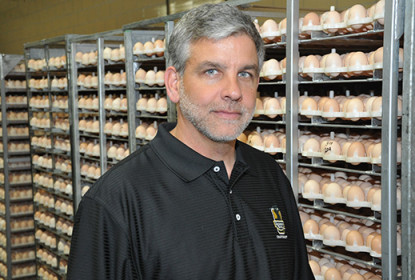
Biosecurity, Expert Advice, Global TOP NEWS, Infectious Diseases, News, PHT GLOBAL, PHT US, Respiratory, TOP NEWS
... Breaches in biosecurity: Sanderson Farms vet shares three valuable lessons
Nov 05, 2015Jennifer GrullonComments Off on Breaches in biosecurity: Sanderson Farms vet shares three valuable lessons
By Philip A. Stayer, DVM Corporate Veterinarian, Sanderson Farms, Inc.... New coccidiosis-management initiative aims to reduce losses
Oct 14, 2015Jennifer GrullonComments Off on New coccidiosis-management initiative aims to reduce losses
Targeting the global poultry industry’s more than $3 billion in annual losses to coccidiosis, Zoetis Inc. introduced a new, science-based initiative to help poultry producers worldwide develop...... Tips for feeding poultry raised without antibiotics
Oct 13, 2015Jennifer GrullonComments Off on Tips for feeding poultry raised without antibiotics
Growers replacing antibiotics in poultry diets face a steep learning curve filled with variables relating to bird health, disease pressure, feed inputs and housing, according to WattAgNet.... Managing ILT: Traditional CEO vaccines still provide ‘best protection’
Sep 30, 2015Jennifer GrullonComments Off on Managing ILT: Traditional CEO vaccines still provide ‘best protection’
John Glisson, DVM — professor emeritus at the University of Georgia and well-known respiratory disease specialist — talks about the ups and downs on infectious laryngotracheitis (ILT) in poultry...... Ionophores look different to other scientists, too
Sep 28, 2015Jennifer GrullonComments Off on Ionophores look different to other scientists, too
Several organizations have drawn the line distinguishing ionophores from other types of antibiotics.... Are ionophores antibiotics? That depends on whom you ask
Sep 28, 2015Jennifer GrullonComments Off on Are ionophores antibiotics? That depends on whom you ask
In the EU — a market often perceived to be less tolerant of antibiotic use in food animals than the US — antibiotics used for growth promotion were banned in 2006. However, certain ionophores,...... Ionophores: The price of elimination
Sep 28, 2015Jennifer GrullonComments Off on Ionophores: The price of elimination
Published reports indicate that poultry operations not using any type of antibiotic, including ionophores, are indeed experiencing setbacks in production and flock welfare.... Omitting ionophores raises ethical conflicts for veterinarians
Sep 28, 2015Jennifer GrullonComments Off on Omitting ionophores raises ethical conflicts for veterinarians
Some advocacy groups believe that more restaurants and foodservice companies should follow the lead of Chipotle, Panera and Chick-fil-A, which only buy chickens raised without any products classified...... Complex broiler-vaccine decisions require expert advice
Sep 28, 2015Jennifer GrullonComments Off on Complex broiler-vaccine decisions require expert advice
Developing a vaccination program targeting optimal performance and return requires more planning and expertise than local “experts” at the farm store can offer.... High stocking density predisposes broilers to NE
Sep 28, 2015Jennifer GrullonComments Off on High stocking density predisposes broilers to NE
High stocking density has adverse effects on broiler welfare and intestinal health and predisposes the birds to necrotic enteritis (NE), according to the results of an experiment conducted by...... The “Huddling Syndrome” in the southeastern US broiler chicken industry: on-going investigations
Sep 27, 2015Jennifer GrullonComments Off on The “Huddling Syndrome” in the southeastern US broiler chicken industry: on-going investigations
By Drs. Alexis Kiers, Samantha Pohl, Holly Sellers, Monique Franca, Brian Jordan, Stephen Roney Poultry Diagnostic and Research Center, University of Georgia, Athens, GA... Sanderson’s Phil Stayer: ‘Sustainability is really nothing new for poultry’
Sep 20, 2015Jennifer GrullonComments Off on Sanderson’s Phil Stayer: ‘Sustainability is really nothing new for poultry’
Maintaining good intestinal health is particularly important for sustainability because the condition of the gut ultimately determines a flock’s growth rate and feed conversion.... ‘Rotate smarter,’ says coccidiosis specialist
Sep 19, 2015Jennifer GrullonComments Off on ‘Rotate smarter,’ says coccidiosis specialist
Poultry producers need to “rotate smarter” and learn the differences between anticoccidials if they want to maintain effective and sustainable coccidiosis-management programs, says well-known...... Will antibiotic-free trend make US broiler producers less competitive?
Sep 17, 2015Jennifer GrullonComments Off on Will antibiotic-free trend make US broiler producers less competitive?
The cascade of food service outlet pledges to purchase only chicken from flocks that have been raised without antibiotics is causing a major shift in how broilers are raised in the US, according to a...... Sustainability: What on earth does it really mean? And how does it apply to poultry health?
Sep 10, 2015Jennifer GrullonComments Off on Sustainability: What on earth does it really mean? And how does it apply to poultry health?
In the poultry industry, sustainability trends are reshaping every link in the production chain. But what exactly does it mean for poultry to be “sustainable”?... Waste-heat recovery system could save millions annually while improving air quality
Sep 09, 2015Jennifer GrullonComments Off on Waste-heat recovery system could save millions annually while improving air quality
A team of researchers and engineers from the University of Missouri has developed a waste-heat recovery system that could lead to significant savings in propane costs for producers heating their...... Sustainability: What does it mean to poultry health?
Aug 27, 2015Jennifer GrullonComments Off on Sustainability: What does it mean to poultry health?
In agriculture, sustainability translates to producing more with less — a goal that morphs into a dire need when looking at global population trends. According to a recent UN report, food...... Eight ways to protect your farm from avian flu this fall
Aug 25, 2015Jennifer GrullonComments Off on Eight ways to protect your farm from avian flu this fall
To prepare for the avian flu this fall, the National Chicken Council (NCC) has identified eight biosecurity principles for broiler and broiler-breeder producers.... British vets question health, welfare of free-range chickens
Aug 25, 2015Jennifer GrullonComments Off on British vets question health, welfare of free-range chickens
While activists tout the happier, healthier life of free-range chickens, veterinarians in Great Britain have expressed concern about their long-term sustainability and increased likelihood of a major...... Vets treat chickens to prevent foodborne illness
Aug 18, 2015Jennifer GrullonComments Off on Vets treat chickens to prevent foodborne illness
In the latest episode of Vets on Call, Dr. Pohl and Dr. Chuck Hofacre of the University of Georgia visit a broiler farm to examine the flock’s response to a vaccine.... Poultry vets are latest focus of popular YouTube series
Aug 16, 2015Jennifer GrullonComments Off on Poultry vets are latest focus of popular YouTube series
The popular YouTube series, Veterinarians on Call, recently turned its cameras on two poultry veterinarians from the University of Georgia to help educate the public on modern poultry production.... How ionophores control coccidiosis
Aug 15, 2015Jennifer GrullonComments Off on How ionophores control coccidiosis
by H. David Chapman, PhD University Professor Department of Poultry Science University of Arkansas... Temperature, relative humidity, bird size affect broiler-house ventilation
Aug 10, 2015Jennifer GrullonComments Off on Temperature, relative humidity, bird size affect broiler-house ventilation
Optimal air quality in tunnel-ventilated broiler houses is a function of temperature, relative humidity, bird heat production and air velocity, according to new research conducted at the University...... Producing Grade A chicken starts in the broiler house
Aug 05, 2015Jennifer GrullonComments Off on Producing Grade A chicken starts in the broiler house
In order to produce Grade A chicken at the processing plant, poultry producers must place healthy chicks and maintain bird quality throughout the life cycle.... Reducing false positives pays in ELISA mycoplasma testing
Aug 05, 2015Jennifer GrullonComments Off on Reducing false positives pays in ELISA mycoplasma testing
Poultry producers should consider specificity when selecting a Mycoplasma ELISA test to avoid costs associated with false positives.... Got maxima? New sampling procedure aids detection in broilers
Aug 04, 2015Jennifer GrullonComments Off on Got maxima? New sampling procedure aids detection in broilers
A modified sampling procedure developed by researchers at Zoetis Inc. has dramatically improved the detection of Eimeria maxima infection in broilers.... New app improves cold-weather ventilation for poultry
Aug 03, 2015Jennifer GrullonComments Off on New app improves cold-weather ventilation for poultry
A new app — appropriately named CHKMINVENT — is designed to give poultry producers an easy-to-use means to calculate minimum ventilation rates in their houses during cold weather conditions.... Flu panel examines US control efforts, impacts on trade
Aug 02, 2015Jennifer GrullonComments Off on Flu panel examines US control efforts, impacts on trade
With well over 200 outbreaks affecting more than 47 million poultry over the last six months, highly pathogenic avian influenza (HPAI) is hitting the US poultry industry hard.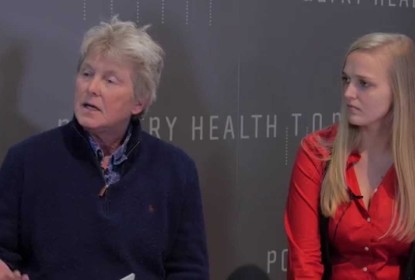
Diagnostics, Global TOP NEWS, Gut Health, ippe2015- Interviews with experts, News, PHT GLOBAL, PHT US, TOP NEWS, Videos
... Coccidiosis research yielding new perspectives on AST
Jul 30, 2015Jennifer GrullonComments Off on Coccidiosis research yielding new perspectives on AST
Adding molecular biology (PCR) to anticoccidial sensitivity testing (AST), offers a more in-depth look — and surprising findings — of Eimeria species contributing to coccidiosis in poultry...... Isolates implicate humans in rapid spread of HPAI
Jul 28, 2015Jennifer GrullonComments Off on Isolates implicate humans in rapid spread of HPAI
A recent analysis of the viral isolates from all outbreaks of highly pathogenic avian influenza (HPAI) in North America points to humans and farm equipment as the leading carriers of the disease from...... Avian flu cases in US expected to decline with warmer temperatures
Jul 21, 2015Jennifer GrullonComments Off on Avian flu cases in US expected to decline with warmer temperatures
USDA is predicting that avian influenza cases will drop off during the spring and summer months. Increased temperatures, decreased humidity and longer periods of ultraviolet light all play a role in...... Reality check: Technically, all poultry in the US is ‘antibiotic-free’
Jul 19, 2015Jennifer GrullonComments Off on Reality check: Technically, all poultry in the US is ‘antibiotic-free’
Confidently presenting facts can go a long way toward shaping consumer opinions about commercial poultry production and the importance of maintaining flock health, welfare and efficiency. For this...... Sanderson CEO gives three reasons for sticking with antibiotics
Jul 18, 2015Jennifer GrullonComments Off on Sanderson CEO gives three reasons for sticking with antibiotics
Count Joe Sanderson Jr., chairman and CEO of Sanderson Farms, as being on the opposite side of the current movement to shift away from the use of antibiotics in poultry production, according to a...... Pathogens on farm and in processing related
Jul 13, 2015Jennifer GrullonComments Off on Pathogens on farm and in processing related
Salmonella and Campylobacter prevalence and loads on the farm are significantly associated with prevalence and loads of the same pathogens at processing.... Avian influenza expected across entire US for fall
Jul 13, 2015Jennifer GrullonComments Off on Avian influenza expected across entire US for fall
The US is preparing for the “worst-case scenario” of highly pathogenic H5N2 avian influenza present in all US flyways during the fall of 2015, explained John Clifford, DVM, chief veterinary...... New tool helps identify Salmonella serotypes
Jul 08, 2015Jennifer GrullonComments Off on New tool helps identify Salmonella serotypes
A new cost-effective diagnostic tool takes aim at identifying numerous serotypes of Salmonella — including the highly virulent Salmonella enterica — which is associated with human illness.... Judicious drug use: The good, the bad and the ugly
Jun 29, 2015Jennifer GrullonComments Off on Judicious drug use: The good, the bad and the ugly
According to FDA, judicious use means administering an antimicrobial drug appropriately — and only when necessary.... FDA Releases Biannual Progress Report on Judicious Use of Antimicrobials in Food-producing Animals
Jun 22, 2015Jennifer GrullonComments Off on FDA Releases Biannual Progress Report on Judicious Use of Antimicrobials in Food-producing Animals
The U.S. Food and Drug Administration announced today its second progress report on its strategy to promote the judicious use of antimicrobials in food-producing animals.... The growing importance of nighttime air quality
Jun 18, 2015Jennifer GrullonComments Off on The growing importance of nighttime air quality
By Drs. Michael Czarick, Brian Fairchild and Brian Jordan Department of Poultry Science, University of Georgia, Athens, GA... Prevention claims essential for ensuring flock health, welfare
Jun 16, 2015Jennifer GrullonComments Off on Prevention claims essential for ensuring flock health, welfare
New FDA guidelines that discourage using medically important antibiotics for promoting growth in food animals appear to have been well-received by both producers and most consumer activists.... Webinar to examine new VFD rules for poultry, livestock
Jun 09, 2015Jennifer GrullonComments Off on Webinar to examine new VFD rules for poultry, livestock
An interactive webinar to help the poultry and livestock industries understand the FDA’s new rules for the Veterinary Feed Directive (VFD) has been set for Wednesday, June 17, at 2 pm EDT.... Guidelines at a glance
Jun 05, 2015Jennifer GrullonComments Off on Guidelines at a glance
Highlights of the new U.S. Food and Drug Administration guidelines for antimicrobial usage in poultry and livestock.... FDA issues rule requiring veterinary supervision of medically important antimicrobials
Jun 02, 2015Jennifer GrullonComments Off on FDA issues rule requiring veterinary supervision of medically important antimicrobials
The US Food and Drug Administration announced today its final rule for the Veterinary Feed Directive (VFD) — a move that is said to be “an important piece of the agency’s overall strategy to...... Poultry vet reviews nuts and bolts of FDA’s new antimicrobial guidelines
May 29, 2015Jennifer GrullonComments Off on Poultry vet reviews nuts and bolts of FDA’s new antimicrobial guidelines
FDA recently rolled out new voluntary guidelines for antimicrobial usage in poultry and livestock — not just how the medications are categorized and prescribed, but also how, when and why they...... What’s causing ‘woody breast’ in poultry?
May 28, 2015Jennifer GrullonComments Off on What’s causing ‘woody breast’ in poultry?
A condition known as “woody breast” is puzzling US poultry scientists investigating why breast-muscle tissue from some broiler flocks is hard and tough instead of tender and juicy.... Walmart, Sam’s Club announce new animal welfare, antibiotic positions
May 27, 2015Jennifer GrullonComments Off on Walmart, Sam’s Club announce new animal welfare, antibiotic positions
Walmart and Sam’s Club recently announced new positions on animal welfare and the responsible use of antibiotics in farm animals.... Ammonia concentration versus ventilation rate
May 26, 2015Jennifer GrullonComments Off on Ammonia concentration versus ventilation rate
Monitoring ammonia levels in poultry houses can help producers to adjust ventilation rates and thus prevent problems.
Global TOP NEWS, Infectious Diseases, ippe2015- Interviews with experts, News, PHT GLOBAL, PHT US, TOP NEWS, Videos
... Poultry vet urges poultry producers to guard against E. coli
May 21, 2015Jennifer GrullonComments Off on Poultry vet urges poultry producers to guard against E. coli
Long regarded as a secondary infection to respiratory disease, E. coli is now rated as a primary infection in many layer and broiler-breeder flocks, according to Jose Linares, DVM and technical...... Experience with GA 08 provides valuable information about IBV variants in poultry
May 08, 2015Jennifer GrullonComments Off on Experience with GA 08 provides valuable information about IBV variants in poultry
Experience with Georgia 2008 (GA 08) — the infectious bronchitis variant that’s caused major economic losses for poultry producers in the Southeast — has provided valuable information that will...... Media consultant: Let poultry vets tell the antibiotic story
May 07, 2015Jennifer GrullonComments Off on Media consultant: Let poultry vets tell the antibiotic story
The U.S. poultry industry needs to do a better job telling its story about antibiotics and their role in sustainable production and flock welfare, according to Frank Singleton, a media consultant...... Leading welfare, food-safety groups urge chicken Industry to reduce antibiotics responsibly
May 05, 2015Jennifer GrullonComments Off on Leading welfare, food-safety groups urge chicken Industry to reduce antibiotics responsibly
ASPCA (American Society for the Prevention of Cruelty to Animals) and Center for Food Safety: "Eliminating the routine use of [antibiotics] without addressing the birds’ underlying health problems...
Antibiotic-free, Global TOP NEWS, Gut Health, ippe2015- Interviews with experts, News, PHT GLOBAL, PHT US, TOP NEWS, Videos
... Poultry specialist offers tips for managing gut health through better nutrition
Apr 30, 2015Jennifer GrullonComments Off on Poultry specialist offers tips for managing gut health through better nutrition
Nutritionist Brett Lumpkins, PhD, of Southern Poultry Research, Athens, Georgia, talks about antibiotic-free poultry production, the challenges it presents and how rations can be adjusted for better...... Shrewd moves: Like a chess match, anticoccidial rotation is a game of strategy at Wayne Farms
Apr 29, 2015Jennifer GrullonComments Off on Shrewd moves: Like a chess match, anticoccidial rotation is a game of strategy at Wayne Farms
Your next move might address an immediate need, but it also could determine what pieces are still standing later in the match.
Global TOP NEWS, ippe2015- Interviews with experts, News, PHT GLOBAL, PHT US, Sustainability, TOP NEWS, Videos
... Defining, and demonstrating, sustainability in the poultry industry
Apr 22, 2015Jennifer GrullonComments Off on Defining, and demonstrating, sustainability in the poultry industry
Billy Hargis, PhD, University of Arkansas, thinks the US poultry industry has already set high standards for sustainability, but its efforts are largely misunderstood and unappreciated.... What’s left if we lose antibiotics?
Apr 20, 2015Jennifer GrullonComments Off on What’s left if we lose antibiotics?
Bacterial resistance is developing quickly and many critically important drugs risk becoming obsolete. Disastrous consequences lie in wait therefore unless these drugs are used prudently.... Studies demonstrate the benefits of dual-needle in ovo vaccine delivery
Apr 20, 2015Jennifer GrullonComments Off on Studies demonstrate the benefits of dual-needle in ovo vaccine delivery
by Taylor Barbosa, DVM, PhD, ACPV, Director of Outcomes Research, Zoetis Inc.... Coccidiosis expert: Timing and combination of cocci control methods critical
Apr 18, 2015Jennifer GrullonComments Off on Coccidiosis expert: Timing and combination of cocci control methods critical
Greg Mathis, PhD, of Southern Poultry Research, Athens, Georgia, talks about the continued challenges managing coccidiosis and offers suggestions for improving management programs targeting the...... USDA proposes new measures to reduce Salmonella, Campylobacter
Apr 06, 2015Jennifer GrullonComments Off on USDA proposes new measures to reduce Salmonella, Campylobacter
The USDA’s Food Safety and Inspection Service (FSIS) on January 21 proposed new federal standards to reduce Salmonella and Campylobacter in ground chicken and turkey products as well as raw chicken...... Broiler chicks show less tendon swelling, weight suppression in reovirus vaccine study
Apr 02, 2015Jennifer GrullonComments Off on Broiler chicks show less tendon swelling, weight suppression in reovirus vaccine study
A recent study showed that broiler chicks receiving higher reovirus antibody levels from conventionally vaccinated hens had a lower incidence of tendon swelling and were protected from weight...... Salmonella and coccidiosis: Is there a connection?
Mar 25, 2015Jennifer GrullonComments Off on Salmonella and coccidiosis: Is there a connection?
Chuck Hofacre, DVM, PhD, of the University of Georgia, talks about the relationship of salmonella and coccidiosis in poultry. He also offers tips for minimizing the presence of salmonella in live...... Industry roundtable: Raising poultry without antibiotics
Mar 19, 2015Jennifer GrullonComments Off on Industry roundtable: Raising poultry without antibiotics
Antibiotic-free poultry production remains uncharted territory that’s yielding varied results, a few surprises and an ethical dilemma for veterinarians, poultry experts said at an industry...... Potential link found between DDGS, necrotic enteritis in broilers
Mar 18, 2015Jennifer GrullonComments Off on Potential link found between DDGS, necrotic enteritis in broilers
USPOULTRY and the USPOULTRY Foundation announce the completion of a funded research project at Auburn University, Auburn, Ala., that found a potential link between feeding DDGS and necrotic enteritis...... Action on antibiotics
Mar 10, 2015Jennifer GrullonComments Off on Action on antibiotics
In a March 3 announcement, McDonald’s said that while it would only source chicken raised without antibiotics important to human medicine, “the farmers who supply chicken for its menu will...... CDC turns to Yelp for tracking reports of foodborne illness
Mar 05, 2015Jennifer GrullonComments Off on CDC turns to Yelp for tracking reports of foodborne illness
The Centers for Disease Control (CDC) recently posted analysis of using the urban business-review site Yelp to identify unreported outbreaks of foodborne illness, reports the latest edition of...... White House forum targets antibiotic resistance, promotes responsible use in farm animals
Mar 05, 2015Jennifer GrullonComments Off on White House forum targets antibiotic resistance, promotes responsible use in farm animals
A recent White House forum on antibiotic stewardship brought together more than 150 key players from human and animal health constituencies in an effort to ensure responsible antibiotic use and...... Editorial: The animal doctor’s dilemma
Mar 05, 2015Jennifer GrullonComments Off on Editorial: The animal doctor’s dilemma
Today, some poultry veterinarians are being asked to avoid using antibiotics that have been reviewed, approved and licensed for use in poultry and other species by the US FDA.... FDA finds positive and negative trends in antimicrobial resistance in bacteria isolated from humans, retail meats and food animals
Mar 04, 2015Jennifer GrullonComments Off on FDA finds positive and negative trends in antimicrobial resistance in bacteria isolated from humans, retail meats and food animals
The Food and Drug Administration has released its National Antimicrobial Resistance Monitoring System (NARMS) 2011 Executive Report, showing both increasing and decreasing antimicrobial resistance...... ‘Location, location, location’ keys to successful in ovo vaccination
Mar 03, 2015Jennifer GrullonComments Off on ‘Location, location, location’ keys to successful in ovo vaccination
By Tarsicio Villalobos, DVM Director, Technical Service Zoetis Inc.... Link between fishmeal, Eimeria and necrotic enteritis in broilers explored
Feb 28, 2015Jennifer GrullonComments Off on Link between fishmeal, Eimeria and necrotic enteritis in broilers explored
Insights into how fishmeal in poultry rations and Eimeria infection may predispose broilers to necrotic enteritis come from a study by Australian investigators.... Animal antibiotic study launched by Colorado State University
Feb 27, 2015Jennifer GrullonComments Off on Animal antibiotic study launched by Colorado State University
Colorado State University researchers are conducting a series of studies to track antibiotic-resistant bacteria in the animal agriculture industry in an effort to determine if farm practices are...... Isolation of Campylobacter from the circulating blood of broilers
Feb 26, 2015Jennifer GrullonComments Off on Isolation of Campylobacter from the circulating blood of broilers
From a poultry processing viewpoint, Campylobacter presence in circulating blood of market-age broilers may increase the likelihood of cross-contamination between birds during slaughter.... Poultry vet offers tips for managing vaccination programs for infectious bursal disease (IBD)
Feb 26, 2015Jennifer GrullonComments Off on Poultry vet offers tips for managing vaccination programs for infectious bursal disease (IBD)
Producers have many options for vaccinating for infectious bursal disease (IBD), but there’s no blanket program for all operations or all seasons. Kalen Cookson, DVM, a veterinarian for Zoetis,...... Trade-offs needed in gangrenous dermatitis management
Feb 25, 2015Jennifer GrullonComments Off on Trade-offs needed in gangrenous dermatitis management
Don Ritter, DVM, of Mountaire Farms, Millsboro, Delaware, discusses his experiences managing gangrenous dermatitis in broilers, the disease’s relationship with coccidiosis and what producers can do...... Poultry research showcased at SCAD: students shine
Feb 24, 2015Jennifer GrullonComments Off on Poultry research showcased at SCAD: students shine
Mark Jackwood, PhD, University of Georgia talks about the recent Southern Conference of Avian Diseases (SCAD) and its significance to the poultry industry.... Farmer voice matters in building consumer trust
Feb 16, 2015Jennifer GrullonComments Off on Farmer voice matters in building consumer trust
Farmers will need to engage in conversations with consumers for the long term if they are to build trust in today’s food system.... Reduce odor from manure with free online tool
Feb 13, 2015Jennifer GrullonComments Off on Reduce odor from manure with free online tool
A team of Iowa State University (ISU) Extension and Outreach specialists have developed an online tool to help livestock and poultry producers compare odor mitigation techniques that could be useful...... Attracting new blood to poultry health
Feb 08, 2015Jennifer GrullonComments Off on Attracting new blood to poultry health
J. H. “Jim"" Denton, professor emeritus at the University of Arkansas, talks about the declining number of veterinarians and other poultry health professionals entering the industry and, more...... University of Arkansas faculty lead Poultry Sustainability Summit at International Conference
Feb 03, 2015Jennifer GrullonComments Off on University of Arkansas faculty lead Poultry Sustainability Summit at International Conference
University of Arkansas professors Marty Matlock and Greg Thoma led a sustainability workshop at the 2015 International Production and Processing Expo in Atlanta, Georgia.... Economic benefits of early chick placement
Jan 30, 2015Jennifer GrullonComments Off on Economic benefits of early chick placement
Taylor Barbosa, DVM, of Zoetis looks at research showing the benefits getting chicks on the floor as soon as possible.... IPPE 2015 breaks records for registrants and exhibitors
Jan 30, 2015Jennifer GrullonComments Off on IPPE 2015 breaks records for registrants and exhibitors
The 2015 International Production & Processing Expo (IPPE) is the largest show on record with an estimated 30,000 poultry, meat and feed industry leader attendees from all over the world.... Improving Rapid Detection Methods for Foodborne Pathogens
Jan 30, 2015Jennifer GrullonComments Off on Improving Rapid Detection Methods for Foodborne Pathogens
Researchers have developed a microfluidic device that exploits cell movement to separate live and dead bacteria during food processing.... Sanderson Farms’ Phil Stayer: ‘Mortality is the first measure of wellbeing’
Jan 30, 2015Jennifer GrullonComments Off on Sanderson Farms’ Phil Stayer: ‘Mortality is the first measure of wellbeing’
Phil Stayer, DVM, of Sanderson Farms says poultry health, welfare and sustainability should not be compromised for marketing purposes.... The changing face of reovirus in poultry
Jan 30, 2015Jennifer GrullonComments Off on The changing face of reovirus in poultry
Don Waldrip, DVM, of Zoetis talks about new variants or reovirus in poultry and the best ways to manage it.... Correlating lesion scores to microscores creates statistical model for efficacy, feed conversion in poultry
Jan 30, 2015Jennifer GrullonComments Off on Correlating lesion scores to microscores creates statistical model for efficacy, feed conversion in poultry
Georgia researcher Lorraine Fuller and graduate student Miguel Barrios, at University of Georgia, build new statistical model that saves poultry producers time and money by correlating lesion scores...... Sustainability: ‘It’s about continuous improvement’
Jan 29, 2015Jennifer GrullonComments Off on Sustainability: ‘It’s about continuous improvement’
Marty Matlock and Gregory Thoma of the University of Arkansas define sustainability as “continuous improvement” and discuss both the track record and the challenges of today’s poultry... Infectious bronchitis constantly evolving making it a tough target
Jan 28, 2015Jennifer GrullonComments Off on Infectious bronchitis constantly evolving making it a tough target
Infectious bronchitis may not show symptoms in live birds but surprises poultry producers with condemnations at processing, says Tim Cummings, DVM, technical service veterinarian for Zoetis.... Regulatory expert urges poultry producers to document, document, document
Jan 28, 2015Jennifer GrullonComments Off on Regulatory expert urges poultry producers to document, document, document
Henry Turlington, PhD, of AFIA, points out the implications of the new Food Safety and Modernization Act (FSMA) regulations and the need for improved communication and record keeping for poultry...... Infectious bronchitis: A moving target
Jan 28, 2015Jennifer GrullonComments Off on Infectious bronchitis: A moving target
University of Georgia’s Mark Jackwood, PhD, explains why infectious bronchitis keeps evolving and what poultry producers should do to stay ahead of the costly disease.... IPSF: Feed Sustainability in Theory and Practice
Jan 28, 2015Jennifer GrullonComments Off on IPSF: Feed Sustainability in Theory and Practice
US - On the opening day of the International Poultry Scientific Forum (IPSF) in Atlanta, 26 January, sustainability of the feed sector was among the topics addressed.... Frequent Application of Litter Amendments in Broiler Houses During Grow-out on Bird Health, Production and Environment
Jan 28, 2015Jennifer GrullonComments Off on Frequent Application of Litter Amendments in Broiler Houses During Grow-out on Bird Health, Production and Environment
A series of experiments at the University of Delaware show that frequent application of sodium bisulphate improved broiler production performance and foot pad quality and reduced ammonia emissions...... US Poultry Industry Responds to New Food Safety Proposal
Jan 28, 2015Jennifer GrullonComments Off on US Poultry Industry Responds to New Food Safety Proposal
The industry body, the National Chicken Council and one poultry processor have welcomed the aims of the recently announced proposal to reduce Salmonella and Campylobacter on poultry parts... S. Heidelberg colonization reduced with in-feed treatment
Jan 28, 2015Jennifer GrullonComments Off on S. Heidelberg colonization reduced with in-feed treatment
Broilers that received bacitracin methylene disalicylate (BMD®) plus a probiotic selected for its ability to survive the feed-pelleting process had a markedly lower prevalence of Salmonella...... APHIS veterinarian provides latest update on avian influenza
Jan 27, 2015Jennifer GrullonComments Off on APHIS veterinarian provides latest update on avian influenza
The current outbreak of highly-pathogenic avian influenza in British Columbia, Canada, and the Pacific Northwest of the United States is associated with wild bird migration in the Pacific flyway.... Rising issues with coccidiosis and necrotic enteritis
Jan 27, 2015Jennifer GrullonComments Off on Rising issues with coccidiosis and necrotic enteritis
Suzanne Dougherty, DVM, encourages “back to basics” with gut-health management while exploring new options... A look at animal wellbeing in the poultry industry
Jan 27, 2015Jennifer GrullonComments Off on A look at animal wellbeing in the poultry industry
Yvonne Vizzier Thaxton talks about animal wellbeing–the entire system of the animal including general health, behavior, nutrition, disease prevention–and how it contributes to...
Antibiotic-free, Global TOP NEWS, Gut Health, ippe2015- Highlights from our latest issue, News, PHT GLOBAL, PHT US, Sustainability, TOP NEWS
... Roundtable highlights: Raising poultry without antibiotics
Jan 27, 2015Jennifer GrullonComments Off on Roundtable highlights: Raising poultry without antibiotics
Antibiotic-free poultry production remains uncharted territory that’s yielding varied results, a few surprises and an ethical dilemma for veterinarians, poultry experts said at an industry...... How to make the most of your visit to the 2015 IPPE
Jan 26, 2015Jennifer GrullonComments Off on How to make the most of your visit to the 2015 IPPE
Industry leaders from all over the world will once again meet at the Georgia World Congress Center in Atlanta for the 2015 International Production & Processing Expo (IPPE) January 27-29... Keys to successful ABF production
Jan 22, 2015Jennifer GrullonComments Off on Keys to successful ABF production
Poultry health experts at a recent industry roundtable offered these suggestions for successful antibiotic-free production... What poultry is really raised without antibiotics?
Jan 22, 2015Jennifer GrullonComments Off on What poultry is really raised without antibiotics?
A variety of terms are used to describe poultry raised without antibiotics. Some are USDA approved and verified, but others are not. Here’s a look at what consumers are seeing in their meat cases,...... Sericea lespedeza found ineffective for coccidiosis control in chickens
Jan 22, 2015Jennifer GrullonComments Off on Sericea lespedeza found ineffective for coccidiosis control in chickens
Sericea lespedeza (SL), a warm-season legume shown to help control coccidiosis in lambs, had no anticoccidial activity in chickens, according to a study conducted at the University of Arkansas.... It’s back: Zoamix® adds flexibility to rotation plans
Jan 22, 2015Jennifer GrullonComments Off on It’s back: Zoamix® adds flexibility to rotation plans
Zoetis Inc. has relaunched Zoamix® (zoalene), a versatile synthetic anticoccidial for the prevention and control of coccidiosis in broilers and turkeys.... Coccidiosis: Why is it so difficult to manage?
Jan 22, 2015Jennifer GrullonComments Off on Coccidiosis: Why is it so difficult to manage?
With more than a dozen antimicrobials and a half dozen vaccines available for coccidiosis, why are US poultry producers still having such a difficult time managing this costly disease?... Memorable quotes and figures from the world of poultry health
Jan 22, 2015Jennifer GrullonComments Off on Memorable quotes and figures from the world of poultry health
... Sustainability ‘most highly discussed topic’ in poultry industry
Jan 14, 2015Jennifer GrullonComments Off on Sustainability ‘most highly discussed topic’ in poultry industry
Sustainability was the “most highly discussed topic” in the poultry industry during the second half of 2014, according to the current issue of Influence Feed, a newsletter published by Zoetis.... New vet oversight rules will affect more than half antimicrobials sold
Jan 08, 2015Jennifer GrullonComments Off on New vet oversight rules will affect more than half antimicrobials sold
In two years time, regulatory changes will come into effect that will cover 57 per cent of current antimicrobial sales for animals in the US.... Poultry disease identification made easier with test alteration
Dec 22, 2014Jennifer GrullonComments Off on Poultry disease identification made easier with test alteration
USDA scientists have found a way to make it easier to detect avian reticuloendotheliosis and Marek's disease by modifying an already available test.... AAAP-AVMA antimicrobial guidelines stress good management, judicious use
Dec 15, 2014Jennifer GrullonComments Off on AAAP-AVMA antimicrobial guidelines stress good management, judicious use
Recent guidelines from the American Association of Avian Pathologists and the American Veterinary Medical Association outline the judicious therapeutic use of antimicrobials while focusing on the...... Doing a 180: A little education goes a long way toward changing customers’ attitudes about antibiotics
Dec 11, 2014Jennifer GrullonComments Off on Doing a 180: A little education goes a long way toward changing customers’ attitudes about antibiotics
Back in 2008, Pfizer Animal Health (now Zoetis Inc.) conducted market research to get a better handle on consumer opinions about the use of antibiotics...... Too busy for sustainability? Think again
Dec 04, 2014Jennifer GrullonComments Off on Too busy for sustainability? Think again
Sure, sustainability is a sound and noble concept — something everyone needs to think about and practice — but try telling that to a veterinarian or producer in the middle of an infectious...... Field trials show practical, economic benefits of E. coli vaccine in broilers
Nov 13, 2014Jennifer GrullonComments Off on Field trials show practical, economic benefits of E. coli vaccine in broilers
Recent studies on two continents have demonstrated that a modified-live vaccine reduced losses from Escherichia coli in broilers, even when the disease challenge was strong.... Let coccidiosis organisms ‘see something different’
Nov 06, 2014Jennifer GrullonComments Off on Let coccidiosis organisms ‘see something different’
Poultry producers are losing ground to coccidiosis because they’re not implementing effective rotation programs that employ different types and classes of anticoccidials, says Don Waldrip, DVM, a...... Facing poultry’s consumer trust challenge
Nov 06, 2014Jennifer GrullonComments Off on Facing poultry’s consumer trust challenge
Where does poultry stand with consumers on issues such as antibiotic usage, animal welfare and food safety? What must be done to strengthen trust in poultry and the companies that produce it? Five...... Facing poultry’s consumer trust challenge
Nov 06, 2014Jennifer GrullonComments Off on Facing poultry’s consumer trust challenge
Where does poultry stand with consumers on issues such as antibiotic usage, animal welfare and food safety? What must be done to strengthen trust in poultry and the companies that produce it? Five...... Poultry welfare – expectations and reality
Nov 06, 2014Jennifer GrullonComments Off on Poultry welfare – expectations and reality
Welfare of poultry, especially laying hens, has become a major issue for commercial poultry producers in the last 15 to 20 years. What is happening to the commercial egg business is also setting the...... Antibiotic-free broiler production requires a paradigm shift
Nov 04, 2014Jennifer GrullonComments Off on Antibiotic-free broiler production requires a paradigm shift
Producers, veterinarians and nutritionists agree that antibiotic-free broiler production in the U.S. will place greater emphasis on farm management and nutrition.... Being more transparent: Media experts offer tips to poultry companies
Oct 30, 2014Jennifer GrullonComments Off on Being more transparent: Media experts offer tips to poultry companies
Between fast and easy Internet access, hundreds of cable channels, the explosion of social media, the rise of “citizen journalism” and the emergence of new digital news hubs and blogs, keeping...... Media specialist: ‘Get on the same message’ with poultry antibiotics, other topics
Oct 27, 2014Jennifer GrullonComments Off on Media specialist: ‘Get on the same message’ with poultry antibiotics, other topics
The poultry industry needs to “get on the same message” when talking about judicious antibiotic usage and other production topics, says Bryan Reber, PhD, a professor of public relations at the...... Breakthrough in coccidiosis research at Royal Veterinary College
Oct 27, 2014Jennifer GrullonComments Off on Breakthrough in coccidiosis research at Royal Veterinary College
Biological researchers at the University of London’s Royal Veterinary College (RVC) are a step closer to finding a new cost-effective vaccine for the intestinal disease, coccidiosis.... Life without antibiotics in poultry production
Oct 22, 2014Jennifer GrullonComments Off on Life without antibiotics in poultry production
U.S. poultry producers are using fewer and less antibiotics in broiler flocks as public concern over the use of antibiotics in food-producing animals intensifies.... Food industry consultant urges poultry industry to engage, educate customers through social media
Oct 20, 2014Jennifer GrullonComments Off on Food industry consultant urges poultry industry to engage, educate customers through social media
Today’s consumers are smarter, more engaged and “assume a certain amount of control over the things in their lives that they feel passionate about” says food industry consultant Frank...... Feed management for layers in enriched colonies
Oct 20, 2014Jennifer GrullonComments Off on Feed management for layers in enriched colonies
Enriched colonies are gaining ground in countries outside the EU, where they have been enforced by law, but how to best feed hens in this new housing system remains a matter of discovery.... Five ways to put sustainability into action today
Oct 16, 2014Jennifer GrullonComments Off on Five ways to put sustainability into action today
So how can commercial poultry producers make their poultry-health programs more sustainable — ethically, environmentally and economically?... Coccidiosis control takes long-term planning
Oct 15, 2014Jennifer GrullonComments Off on Coccidiosis control takes long-term planning
By Donald Waldrip, Senior Technical Services Veterinarian, Zoetis Inc.... Antibiotics in livestock and poultry production
Oct 14, 2014Jennifer GrullonComments Off on Antibiotics in livestock and poultry production
Antibiotic use and antibiotic resistance in humans and animals are some of the most complex topics that reporters are asked to cover. Being mindful of key words and statistics can help reporters...... Bone characteristics and femoral strength in commercial tom turkeys
Oct 13, 2014Jennifer GrullonComments Off on Bone characteristics and femoral strength in commercial tom turkeys
Reducing the energy and protein levels in the diet of male turkeys to 60 per cent of NRC recommendations improved both the strength and quality of the leg bones in a Michigan State University...... FDA reports positive trends in antimicrobial resistance
Oct 10, 2014Jennifer GrullonComments Off on FDA reports positive trends in antimicrobial resistance
The annual NARMS Executive Report focuses on resistance to antibiotics that are considered important in human medicine as well as multidrug resistance (described as resistance to three or more...... Practical programs for achieving sustainable coccidiosis control
Oct 09, 2014Jennifer GrullonComments Off on Practical programs for achieving sustainable coccidiosis control
By H. David Chapman, PhD University Professor, Department of Poultry Science, University of Arkansas... New antibiotic initiatives spark more debate in Washington
Sep 30, 2014Jennifer GrullonComments Off on New antibiotic initiatives spark more debate in Washington
The President's Council of Advisors on Science and Technology released a report Sept. 18 on combating antibiotic resistance, which accompanied the president's executive order to create a government...... Layers 2013 Part 1: Reference of health and management practices on table-egg farms in the United States, 2013
Sep 29, 2014Jennifer GrullonComments Off on Layers 2013 Part 1: Reference of health and management practices on table-egg farms in the United States, 2013
An overview of egg flock management in the US, based on a detailed survey of 328 farms with at least 3,000 birds across 19 states by the USDA Animal and Plant Health Inspection Service (APHIS). The...... USDA announces new inspection system for poultry products
Sep 26, 2014Jennifer GrullonComments Off on USDA announces new inspection system for poultry products
The US Department of Agriculture's (USDA) Food Safety and Inspection Service (FSIS) last week announced a critical step forward in making chicken and turkey products safer for Americans to eat.... USDA announces new inspection system for poultry products
Sep 26, 2014Jennifer GrullonComments Off on USDA announces new inspection system for poultry products
The US Department of Agriculture's (USDA) Food Safety and Inspection Service (FSIS) last week announced a critical step forward in making chicken and turkey products safer for Americans to eat.... Kinky back takes costly toll on broilers at 4 to 6 weeks
Sep 24, 2014Jennifer GrullonComments Off on Kinky back takes costly toll on broilers at 4 to 6 weeks
Broiler producers are being urged to watch for signs of kinky back, an emerging bacterial disease of poultry that can cause significant losses in birds 4 to 6 weeks of age.... Campylobacter research reveals potential for poultry vaccine
Sep 19, 2014Jennifer GrullonComments Off on Campylobacter research reveals potential for poultry vaccine
Researchers at the USDA Richard B. Russell Agricultural Research Center have purified proteins from Campylobacter and tested them for their potential use as vaccines.... Poultry disease prevention checklist
Sep 15, 2014Jennifer GrullonComments Off on Poultry disease prevention checklist
Dr Casey Ritz of the University of Georgia presents a checklist for poultry farmers to assess the biosecurity risk on their farm.... Five reasons for the poultry industry not to be transparent
Sep 12, 2014Jennifer GrullonComments Off on Five reasons for the poultry industry not to be transparent
What are the top reasons the poultry industry isn’t transparent with the public? Todd Simmons, CEO and vice chair, Simmons Foods, named five in a speech at the Arkansas Nutrition Conference, but he...... Coccidiosis specialist: ‘Understand’ the products you’re using
Sep 11, 2014Jennifer GrullonComments Off on Coccidiosis specialist: ‘Understand’ the products you’re using
Coccidiosis has been around as long as any poultry producer can remember. And despite decades of experience with the tenacious parasitic disease, it hasn’t gotten any easier to manage. In fact,...... Researchers find potential link between feeding DDGS and necrotic enteritis in broilers
Sep 09, 2014Jennifer GrullonComments Off on Researchers find potential link between feeding DDGS and necrotic enteritis in broilers
High levels of DDGS (15%) were found in studies at Auburn University to amplify mild to moderate cases of necrotic enteritis into more severe cases.... Author of California bill defends using antibiotics to prevent disease
Aug 28, 2014Jennifer GrullonComments Off on Author of California bill defends using antibiotics to prevent disease
California lawmakers passed SB-835 (Food animals: medically important antimicrobial drugs), which mirrors the U.S. Food and Drug Administration's Guidance 213 (covered in Influence Feed edition "Real...... Zoetis receives full license for Georgia 08 IB vaccine
Aug 27, 2014Jennifer GrullonComments Off on Zoetis receives full license for Georgia 08 IB vaccine
Zoetis Inc. has obtained a full license from the USDA to sell Poulvac® Bron GA 08, the first commercially available vaccine to reduce disease caused by Georgia 2008 (GA 08) Type infectious...... Activist groups defeated in attempts to curb antibiotic use
Aug 13, 2014Jennifer GrullonComments Off on Activist groups defeated in attempts to curb antibiotic use
Two activist efforts recently suffered defeats in attempts to curb antibiotic use in US animal agriculture... Avian Mycoplasma diagnostics
Aug 04, 2014Jennifer GrullonComments Off on Avian Mycoplasma diagnostics
By Naola Ferguson-Noel, Poultry Diagnostic and Research Center, Department of Population Health, University of Georgia, Athens, GA... Control of avian mycoplasmosis
Aug 04, 2014Jennifer GrullonComments Off on Control of avian mycoplasmosis
By Naola Ferguson-Noel, Poultry Diagnostic and Research Center, Department of Population Health, University of Georgia, Athens, GA... PCR: A simple explanation
Aug 04, 2014Jennifer GrullonComments Off on PCR: A simple explanation
By Mark Jackwood, Poultry Diagnostic and Research Center, Department of Population Health, University of Georgia, Athens, GA... Temperature of drinking water may affect bodyweight during brooding
Jul 19, 2014Jennifer GrullonComments Off on Temperature of drinking water may affect bodyweight during brooding
The temperature of drinking water during brooding may affect the bodyweight of broiler chicks, according to a University of Arkansas study.... S. enteritidis frequency in eggs similar in conventional and enriched cage systems
Jul 19, 2014Jennifer GrullonComments Off on S. enteritidis frequency in eggs similar in conventional and enriched cage systems
The frequency of egg contamination with S. enteritidis did not significantly differ between hens housed in conventional and enriched cages, investigators say in the March 2014 issue of Poultry...... Cracked corn has positive effect in broilers
Jul 19, 2014Jennifer GrullonComments Off on Cracked corn has positive effect in broilers
Cracked corn fed to broilers increased weight gain and gizzard size and had a positive effect on gut microflora, say New Zealand investigators.... Making sense of poultry labels
Jul 19, 2014Jennifer GrullonComments Off on Making sense of poultry labels
Demand for increased transparency has led to the proliferation of poultry labeling terms — many of which surface in discussions about sustainability and production practices. What these terms...... Timing may affect accuracy of in ovo vaccination
Jul 19, 2014Jennifer GrullonComments Off on Timing may affect accuracy of in ovo vaccination
The coccidiosis vaccine Inovocox® EM1 was more precisely deposited to embryos when the vaccine was administered at 18.5 versus 19 days of incubation, indicates a Zoetis-sponsored study from...... Editorial: Never say never
Jul 19, 2014Jennifer GrullonComments Off on Editorial: Never say never
Not that long ago, the thought of raising broilers on a large scale without ionophores or other intestinal health antibiotics would have seemed foolhardy. But that has changed in recent years, as...... Sustainability tops list of poultry topics during first half of 2014
Jul 18, 2014Jennifer GrullonComments Off on Sustainability tops list of poultry topics during first half of 2014
Sustainability was the most highly discussed topic in the US poultry industry during the first half of 2014, according to an analysis by Influence Feed.... Get the most from your ELISA tests
Jul 15, 2014Jennifer GrullonComments Off on Get the most from your ELISA tests
Andrea Zedek, a veterinarian at Zoetis Inc., offers tips for ensuring accuracy when using ELISA tests to diagnose a poultry flock's health status.... New FDA antibiotic guidelines: What’s a VFD?
Jul 04, 2014Jennifer GrullonComments Off on New FDA antibiotic guidelines: What’s a VFD?
The phrase Veterinary Feed Directive (VFD) may be new to poultry veterinarians and producers, but the process has actually been around since 1996, when Congress passed the Animal Drug Availability...... #152 Guidance for Industry: Evaluating the safety of antimicrobial new animal drugs with regard to their microbiological effects on bacteria of human health concern
Jul 03, 2014Jennifer GrullonComments Off on #152 Guidance for Industry: Evaluating the safety of antimicrobial new animal drugs with regard to their microbiological effects on bacteria of human health concern
Appendix A of this document ranks antimicrobial drugs according to their importance in human medicine and may be updated by FDA.... New FDA antibiotic guidelines: Why comply?
Jul 02, 2014Jennifer GrullonComments Off on New FDA antibiotic guidelines: Why comply?
FDA’s new antimicrobial guidelines are strictly voluntary — to a degree. In the agency’s own words, they “do not establish legally enforceable responsibilities”; they merely “describe the...... Feeling misunderstood? Vet urges producers to take action
Jul 01, 2014Jennifer GrullonComments Off on Feeling misunderstood? Vet urges producers to take action
Don’t blame consumers if they seem to have little understanding of modern poultry and livestock production. “It’s not their fault and it is not intentional. It is just the way society has...... Should antibiotics be used to prevent disease in poultry?
Jun 19, 2014Jennifer GrullonComments Off on Should antibiotics be used to prevent disease in poultry?
Three veterinarians explain why they think it's a sensible and ethical thing to do with certain diseases.... Should antibiotics be used to prevent disease in poultry?
Jun 19, 2014Jennifer GrullonComments Off on Should antibiotics be used to prevent disease in poultry?
Using antibiotics to prevent — not just treat or control — certain diseases of poultry is a sensible, responsible and ethical practice, according to three veterinarians featured on an industry...... Coccidiosis: Why is it still so difficult to control?
Jun 12, 2014Jennifer GrullonComments Off on Coccidiosis: Why is it still so difficult to control?
Coccidiosis can be extremely difficult to manage in poultry because the organism that causes it "has a tremendous capability to reproduce and it's very resistant to any kind of attempt to destroy...... ‘Organic’ labels for poultry, other foods challenged in recent news reports
Jun 09, 2014Jennifer GrullonComments Off on ‘Organic’ labels for poultry, other foods challenged in recent news reports
Critics of the organic labels for poultry meat and other foods are speaking up, reports the latest edition of Influence Feed.... Intestinal health and necrotic enteritis in broilers
Jun 03, 2014Jennifer GrullonComments Off on Intestinal health and necrotic enteritis in broilers
Management at the farm level (litter quality and composition, lighting programmes, stocking density, drinker management and dietary feed management) are important to control necrotic enteritis,...... Reality check: Oft-cited antibiotic-usage figure mixes numbers from two reports
Jun 03, 2014Jennifer GrullonComments Off on Reality check: Oft-cited antibiotic-usage figure mixes numbers from two reports
Confidently presenting facts — not defensive rhetoric — can go a long way toward shaping consumer opinions about commercial poultry production and the importance of maintaining flock health,...... Reality check: 87% of antibiotics used in animals rarely used in human medicine
Jun 02, 2014Jennifer GrullonComments Off on Reality check: 87% of antibiotics used in animals rarely used in human medicine
Confidently presenting facts — not defensive rhetoric — can go a long way toward shaping consumer opinions about commercial poultry production and the importance of maintaining flock health,...... Reality check: Multidrug-resistant strains of Salmonella rare in humans
Jun 01, 2014Jennifer GrullonComments Off on Reality check: Multidrug-resistant strains of Salmonella rare in humans
Confidently presenting facts — not defensive rhetoric — can go a long way toward shaping consumer opinions about commercial poultry production and the importance of maintaining flock health,...... Antibiotic resistance revisited in recent media reports
May 27, 2014Jennifer GrullonComments Off on Antibiotic resistance revisited in recent media reports
Following the April 2014 World Health Organization (WHO) report warning of a “post-antibiotic era,” Current Biology published the findings of a new study on May 19, reports Influence Feed.... New studies examine effects of lighting on chickens
May 17, 2014Jennifer GrullonComments Off on New studies examine effects of lighting on chickens
Two recent studies show that broilers perform better under LED lighting than fluorescent lamps while layer behaviour is affected by light wavelength.... CDC releases progress report on food safety
Apr 28, 2014Jennifer GrullonComments Off on CDC releases progress report on food safety
The US Centers for Disease Control and Prevention (CDC) released a Foodborne Diseases Active Surveillance Network (FoodNet) report last week indicating that rates of Salmonella recently declined...... Supplemental bacitracin reduces mortality, C. perfringens in broilers
Apr 17, 2014Jennifer GrullonComments Off on Supplemental bacitracin reduces mortality, C. perfringens in broilers
Commercial broilers that received a bacitracin-supplemented diet had less Clostridium perfringens in their gut, according to researchers at Ohio State University.... Getting the best results from veterinary histopathology*
Apr 17, 2014Jennifer GrullonComments Off on Getting the best results from veterinary histopathology*
by Susan Williams, DVM, PhD, ACPV Poultry Diagnostic and Research Center, College of Veterinary Medicine, University of Georgia, Athens, GA... Editorial: ‘To health!’
Apr 17, 2014Jennifer GrullonComments Off on Editorial: ‘To health!’
Welcome to Poultry Health Today, a new magazine we’re sponsoring to keep US producers, veterinarians and nutritionists on top of the latest developments in this critical area of production.... Impact of lighting types on broiler performance
Apr 17, 2014Jennifer GrullonComments Off on Impact of lighting types on broiler performance
A study at the University of Delaware shows that broiler performance in terms of breast and body weights was similar for two poultry-specific LED lamps and incandescent lamps and better than for... FDA issues update on antibiotic guidelines
Apr 13, 2014Jennifer GrullonComments Off on FDA issues update on antibiotic guidelines
The U.S. Food and Drug Administration (FDA) issued on March 26 an Update on Animal Pharmaceutical Industry Response to Guidance #213, which asked animal health companies to voluntarily phase out...... Remembering (and channeling) Dr. Scott Hurd
Apr 11, 2014Jennifer GrullonComments Off on Remembering (and channeling) Dr. Scott Hurd
The last time we talked with Iowa State University’s Dr. Scott Hurd, he was joyfully, if not playfully, musing about all the topics he could cover in his new blog for Poultry Health Today....... ‘Socially responsible’ food production stirs debate
Mar 31, 2014Jennifer GrullonComments Off on ‘Socially responsible’ food production stirs debate
The past few weeks have showcased the exploration of "socially responsible" food production and its consumer appeal, occasionally with contradictory findings, according to the latest edition of...... Experimental and applied approaches to control Salmonella in broiler processing
Mar 17, 2014Jennifer GrullonComments Off on Experimental and applied approaches to control Salmonella in broiler processing
By Dr. Mark E. Berrang USDA—Agricultural Research Service, Russell Research Center, Athens, GA... ‘Influence Feed’ now featured on Poultry Health Today
Mar 13, 2014Jennifer GrullonComments Off on ‘Influence Feed’ now featured on Poultry Health Today
Poultry Health Today is pleased to feature Influence Feed — a biweekly report rounding up the hot topics in food and agriculture, as determined by the most influential voices from across the...... Numbers, figures and the fine print
Mar 11, 2014Jennifer GrullonComments Off on Numbers, figures and the fine print
Between announcing the federal government’s first major updates to the Nutrition Facts panel in 20 years and the restriction of in-school advertising of foods that don’t meet healthy guidelines,...... Poultry veterinarian shares ideas for managing coccidiosis more effectively, economically, sustainably
Feb 28, 2014Jennifer GrullonComments Off on Poultry veterinarian shares ideas for managing coccidiosis more effectively, economically, sustainably
Don Waldrip, DVM, talks about a new a new science-based, global initiative from Zoetis to help poultry producers develop longer term, sustainable management of coccidiosis.... Incentives missing in New Poultry Inspection System, says NCC’s Peterson
Feb 26, 2014Jennifer GrullonComments Off on Incentives missing in New Poultry Inspection System, says NCC’s Peterson
The ability to forgo the SIP waiver process for on-line processing may be the rule’s biggest benefit for the poultry industry, said the National Chicken Council’s Vice President of Science and...... Defining wholesomeness
Feb 25, 2014Jennifer GrullonComments Off on Defining wholesomeness
The past two weeks have featured the convergence of special interest agendas and consumer food trends into a series of high-profile business developments. In particular, Chick-fil-A’s announcement...... Five federal bills seek to curb on-farm antibiotic use
Feb 13, 2014Jennifer GrullonComments Off on Five federal bills seek to curb on-farm antibiotic use
Although FDA has introduced new guidelines for using feed antibiotics in poultry and livestock, some members of Congress would like the industry to go a few steps further.... Transparency or exaggeration?
Feb 11, 2014Jennifer GrullonComments Off on Transparency or exaggeration?
In the past weeks we’ve taken note of two prominent foodservice companies using agricultural practices for marketing positioning. McDonald’s and Chipotle instigated influencer conversation by...... Welcome to Influence Feed
Jan 28, 2014Jennifer GrullonComments Off on Welcome to Influence Feed
Welcome to the Food and Agriculture Influence Feed from Zoetis, a biweekly report rounding up the top topics in food and agriculture, as determined by the most influential voices from across the...... CDC: Widespread use of antibiotics in hospitals is leading cause of resistance
Jan 24, 2014Jennifer GrullonComments Off on CDC: Widespread use of antibiotics in hospitals is leading cause of resistance
The most important cause of antibiotic-resistant infections in people can be attributed to widespread antibiotic use in hospitals, according to the Centers for Disease Control and Prevention (CDC).... Rotecc™ coccidiosis management video
Jan 24, 2014Jennifer GrullonComments Off on Rotecc™ coccidiosis management video
Learn more about the new global coccidiosis-management initiative from Zoetis.... Antibiotic resistance threats in the United States, 2013
Jan 22, 2014Jennifer GrullonComments Off on Antibiotic resistance threats in the United States, 2013
This CDC report explores antimicrobial resistance, one of our most serious health threats. Efforts to prevent such threats build on the foundation of proven public health strategies: immunization,...... Specialists discuss impact of new FDA guidelines
Jan 22, 2014Jennifer GrullonComments Off on Specialists discuss impact of new FDA guidelines
In anticipation of the new FDA guidelines for antibiotic usage, Zoetis, Inc., teamed with Watt Global Media to organize a panel discussion about the future of antibiotics in poultry. Following are...... Veterinarians define judicious antibiotic use in poultry
Jan 21, 2014Jennifer GrullonComments Off on Veterinarians define judicious antibiotic use in poultry
With antibiotics, deciding when to use them is as essential as determining how much.... Using antibiotics to improve flock performance
Jan 21, 2014Jennifer GrullonComments Off on Using antibiotics to improve flock performance
Low doses of some antibiotics can help maintain a healthy flock without increasing drug resistance, according to a University of Minnesota veterinarian.... #209 Guidance for Industry: The judicious use of medically important antimicrobial drugs in food-producing animals.
Jan 15, 2014Jennifer GrullonComments Off on #209 Guidance for Industry: The judicious use of medically important antimicrobial drugs in food-producing animals.
GFI 209 presents the FDA’s recent thinking on the topic and lays out FDA strategy and recommendations.... Methods of diagnosing enteric disease clarified
Jan 15, 2014Jennifer GrullonComments Off on Methods of diagnosing enteric disease clarified
Diagnosing clostridial enteric disease in poultry remains a challenge — primarily because many clostridial species can be a normal inhabitant of the gut, which makes it difficult to determine their...... Increased CVI988 vaccine use credited with decline in Marek’s disease
Jan 15, 2014Jennifer GrullonComments Off on Increased CVI988 vaccine use credited with decline in Marek’s disease
Increased use of CVI988/Rispens vaccines is credited with declines in the incidence of Marek’s disease (MD), according to investigators from USDA‘s Agricultural Research Service.... Single dose of Poulvac IBMM+Ark protects long-lived broilers for at least 9 weeks
Jan 15, 2014Jennifer GrullonComments Off on Single dose of Poulvac IBMM+Ark protects long-lived broilers for at least 9 weeks
One dose of the live, attenuated vaccine Poulvac® IBMM+Ark effectively protected broilers against two infectious bronchitis (IB) strains for at least 9 weeks, a recent study shows.... Better protection shown with recommended Marek’s disease vaccine dose in two genetic lines
Jan 15, 2014Jennifer GrullonComments Off on Better protection shown with recommended Marek’s disease vaccine dose in two genetic lines
The recommended dose of two Marek’s disease virus (MDV) vaccines provided better protection in two genetic lines of meat-type chickens compared to a lower dose, the results of a recent study show,...... Organic raw poultry not necessarily safer
Jan 15, 2014Jennifer GrullonComments Off on Organic raw poultry not necessarily safer
Organic raw poultry is not necessarily safer for consumption than conventionally raised poultry, indicates a study from the University of Tennessee.... New studies examine effects of lighting on chickens
Jan 14, 2014Jennifer GrullonComments Off on New studies examine effects of lighting on chickens
Two recent studies show that broilers perform better under LED lighting than fluorescent lamps while layer behaviour is affected by light wavelength.... Guidance for Industry No 213
Jan 05, 2014Jennifer GrullonComments Off on Guidance for Industry No 213
Provides recommendations and voluntary timelines to voluntarily implement the judicious use of antibiotics in ways that address public health concerns while maintaining the health, performance and...... Research review: What’s new in poultry housing and equipment?
Jan 03, 2014Jennifer GrullonComments Off on Research review: What’s new in poultry housing and equipment?
With animal welfare and the environmental aspects of food animal farming gaining more attention from the public and high feed prices focusing efforts on getting the best performance from poultry,...... Lameness in broilers: Osteomyelitis
Jan 01, 2014Jennifer GrullonComments Off on Lameness in broilers: Osteomyelitis
By Stephen Collett, BScAgric, BVSc, MMedVet, MRCVS, DACPV Poultry Diagnostic and Research Center, College of Veterinary Medicine, University of Georgia


